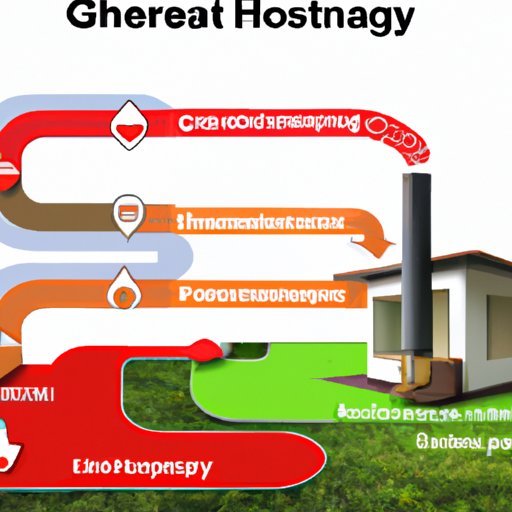Introduction
Geothermal heat is a form of energy that harnesses the natural heat from the Earth’s core to create heating and cooling solutions. It has become increasingly popular in recent years as a more efficient and cost-effective alternative to traditional heating and cooling systems. This article will explore how geothermal heat works, its various benefits, different types of systems, and its cost-effectiveness compared to other heating sources.

Explaining the Basics of Geothermal Heat and its Usage
Geothermal heat is generated by transferring heat from the Earth’s core into buildings or homes through a series of pipes and pumps. This process is made possible by two main components: heat sources and heat pumps. Heat sources are typically located underground and use the Earth’s natural temperature to generate heat. Heat pumps then use this heat to transfer it into the building or home. Heat exchangers are also used to transfer the heat from the heat sources to the heat pumps.

Examining the Benefits of Geothermal Heat
Geothermal heat offers many benefits over traditional heating and cooling systems. The most notable benefits include cost savings, efficiency, and environmental impact.
Cost Savings: One of the biggest advantages of geothermal heat is the potential for significant cost savings. Geothermal systems typically require less energy than traditional heating and cooling systems, which can translate to lower monthly utility bills. Additionally, geothermal systems have fewer maintenance requirements and a longer lifespan, further reducing costs over time.
Efficiency: Geothermal systems are highly efficient, meaning they use less energy to generate the same amount of heat or cooling as traditional systems. This makes them ideal for areas with extreme temperatures or for those who want to reduce their carbon footprint.
Environmental Impact: In addition to being more efficient, geothermal systems also have a much lower environmental impact than other heating and cooling sources. Geothermal systems emit virtually no carbon dioxide, making them an attractive option for those looking to reduce their environmental impact.
Investigating the Different Types of Geothermal Heat Systems
There are three main types of geothermal heat systems: closed loop systems, open loop systems, and pond/lake systems. Each type has its own unique advantages and disadvantages, so it is important to consider all of your options before deciding which type is right for you.
Closed Loop Systems: Closed loop systems are the most common type of geothermal system. They use a network of underground pipes filled with water or an antifreeze solution to transfer heat from the ground to the building or home. The pipes are typically buried several feet below the surface, where the ground stays at a relatively constant temperature year-round. Closed loop systems are generally more efficient and cost-effective than other types of geothermal systems.
Open Loop Systems: Open loop systems are similar to closed loop systems, but instead of using a network of underground pipes, they use a well or body of water to transfer heat from the ground to the building or home. These systems are often cheaper to install than closed loop systems, but they are not as efficient and require more regular maintenance.
Pond/Lake Systems: Pond and lake systems are the least common type of geothermal system. They use a body of water, such as a pond or lake, to transfer heat from the ground to the building or home. These systems are usually the most expensive to install, but they can be very efficient if properly maintained.

Comparing Geothermal Heat to Other Heating Sources
When considering geothermal heat, it is important to compare it to other heating sources. Traditional heating systems, such as furnaces and boilers, are still used in many homes and businesses, but they are becoming increasingly outdated. Air source heat pumps are also becoming more popular as an alternative to traditional systems, but they are not as efficient or cost-effective as geothermal heat.
Exploring the Cost-Effectiveness of Geothermal Heating
Geothermal heating systems can be expensive to install, but they can save you money in the long run. Initial costs vary depending on the size and type of system, but the average cost is around $20,000. However, geothermal systems typically last up to 25 years and can save you up to 70% on your energy bills, making them a cost-effective option in the long run.
Analyzing Geothermal Heat’s Impact on the Environment
Geothermal heat is a clean, renewable energy source that has a minimal impact on the environment. Unlike traditional heating and cooling systems, geothermal systems emit virtually no carbon dioxide and use significantly less energy. Additionally, geothermal systems are powered by renewable sources, such as the Earth’s natural heat, making them an environmentally friendly choice.
Conclusion
In conclusion, geothermal heat is an efficient and cost-effective way to heat and cool your home or business. It uses the natural heat from the Earth’s core to generate heat and cooling, resulting in lower energy costs and a reduced environmental impact. Geothermal systems come in a variety of types and sizes, so it is important to research all of your options before making a decision. Ultimately, geothermal heat is a great choice for those looking to save money and reduce their carbon footprint.
(Note: Is this article not meeting your expectations? Do you have knowledge or insights to share? Unlock new opportunities and expand your reach by joining our authors team. Click Registration to join us and share your expertise with our readers.)
